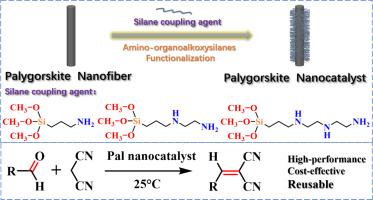氨基有机烷氧基硅烷功能化坡缕石复合纳米催化剂用于Knoevenagel缩合反应
IF 5.8
2区 地球科学
Q2 CHEMISTRY, PHYSICAL
引用次数: 0
摘要
可持续发展的多相碱性催化剂在有机合成中具有重要意义。在这项工作中,三种不同的硅烷偶联剂-硅-1,(3-氨基丙基)三甲氧基硅烷;Sil-2, [3 - (2-aminoethylamino)丙基]trimethoxysilane;和Sil-3,(3-[2-(2-氨基乙基氨基)乙基氨基]丙基三甲氧基硅烷)-通过硅烷化策略接枝到坡高岭土(Pal)上,制备了三种高性能、低成本、可重复使用的氨基有机烷氧基硅烷功能化Pal复合纳米催化剂,分别为Pal- sil -1、Pal- sil -2和Pal-Sil-3。综合表征(FT-IR、TGA、XRD、XPS和SEM)证实了改性催化剂结构完整,并成功引入了氨基活性位点。催化实验表明,Pal-Sil-3在三种不同的纳米催化剂中表现出最好的催化性能,在5 min内实现了苯甲醛和丙二腈在乙醇中的Knoevenagel缩合反应的转化率超过98.5%。它对各种取代芳醛具有广泛的底物适应性,并能有效合成药物中间异构体(Z)-5-苄基-1,3-噻唑烷-2,4-二酮。值得注意的是,Pal-Sil-3保持稳定的催化效率(>;97%的转化率)在连续流系统中,并在五个重复使用循环后保持高活性。该研究为开发环境友好的多相催化体系和α,β-不饱和分子的绿色合成提供了新的策略。本文章由计算机程序翻译,如有差异,请以英文原文为准。

Composite nanocatalysts of amino-organoalkoxysilanes functionalized palygorskite for Knoevenagel condensation reaction
The development of sustainable heterogeneous basic catalysts is of significant importance in organic synthesis. In this work, three different silane coupling agents—Sil-1, (3-aminopropyl)trimethoxysilane; Sil-2, [3-(2-aminoethylamino)propyl]trimethoxysilane; and Sil-3, (3-[2-(2-aminoethylamino)ethylamino]propyltrimethoxysilane)—were grafted onto palygorskite (Pal) via a silanization strategy to prepare three high-performance, cost-effective, and reusable amino-organoalkoxysilane functionalized Pal composite nanocatalysts, namely Pal-Sil-1, Pal-Sil-2, and Pal-Sil-3. Comprehensive characterization (FT-IR, TGA, XRD, XPS, and SEM) confirmed the intact structure of modified catalysts and the successful introduction of amino active sites. Catalytic experiments show that Pal-Sil-3 exhibited the best catalytic performance among the three different nanocatalysts, achieving a conversion exceeding 98.5 % within 5 min for the Knoevenagel condensation of benzaldehyde and malononitrile in ethanol. It exhibited broad substrate adaptability for various substituted aromatic aldehydes and enabled the efficient synthesis of the drug intermediate isomer (Z)-5-benzylidene-1,3-thiazolidine-2,4-dione. Notably, Pal-Sil-3 maintained stable catalytic efficiency (> 97 % conversion) in a continuous flow system and retained high activity after five reuse cycles. This study provides a novel strategy for developing environmentally friendly heterogeneous catalytic systems and green synthesis of α,β-unsaturated molecules.
求助全文
通过发布文献求助,成功后即可免费获取论文全文。
去求助
来源期刊

Applied Clay Science
地学-矿物学
CiteScore
10.30
自引率
10.70%
发文量
289
审稿时长
39 days
期刊介绍:
Applied Clay Science aims to be an international journal attracting high quality scientific papers on clays and clay minerals, including research papers, reviews, and technical notes. The journal covers typical subjects of Fundamental and Applied Clay Science such as:
• Synthesis and purification
• Structural, crystallographic and mineralogical properties of clays and clay minerals
• Thermal properties of clays and clay minerals
• Physico-chemical properties including i) surface and interface properties; ii) thermodynamic properties; iii) mechanical properties
• Interaction with water, with polar and apolar molecules
• Colloidal properties and rheology
• Adsorption, Intercalation, Ionic exchange
• Genesis and deposits of clay minerals
• Geology and geochemistry of clays
• Modification of clays and clay minerals properties by thermal and physical treatments
• Modification by chemical treatments with organic and inorganic molecules(organoclays, pillared clays)
• Modification by biological microorganisms. etc...
 求助内容:
求助内容: 应助结果提醒方式:
应助结果提醒方式:


